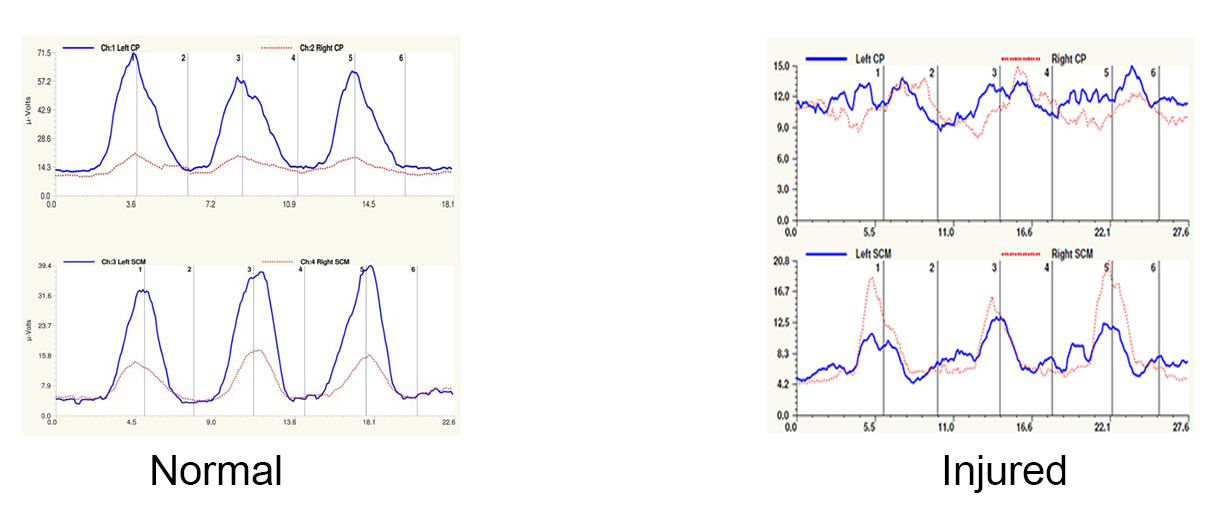
Auto accident injuries occur in milliseconds, too quick for the human nervous system to react and protect. This leaves only bones and ligaments to protect the body. Numerous types of injuries can result. Some of the most common include broken bones, concussion (mild traumatic brain injury, or MTBI), and soft tissue injury (muscle strain and ligament sprains). Of these it is the soft tissue injuries that can often take the longest time to heal and have the highest chance of causing chronic issues that can last for years after the accident.
Part of the problem with soft tissue injuries is that they can be very difficult to objectively diagnose. What this means is that the patient may feel it, but there is little the doctor can do to document the injury and get an idea of its severity. This makes it difficult in many cases to properly treat the injury and thus recovery can be very slow. It also makes it more difficult to defend what you feel in the event of legal proceedings to be compensated for the care you will need.
At Blume Healing Center we have technology that can help us to not only document your soft tissue injuries, but technology that can also help guide us in proper treatment procedures to get you better quicker treat the injuries without all the information.
Depending upon presenting symptoms, we use a combination of these diagnostic tests to help analyze and document your soft tissue injuries:
- Digital Motion X-ray (DMX) – used to assess ligament and bone injuries
- Dynamic Surface Electromyography (sEMG) – used to assess muscle function and firing patterns
- Computer Measured Range of Motion – used to accurately assess joint mobility
Digital Motion X-ray® (DMX®)
DIGITAL MOTION X-RAY® (DMX®) is a diagnostic test that records real time, full motion x-ray imaging of body joints in motion. It is the only diagnostic tool that records in real time as the patient moves in a weight bearing position. Many people who suffer from injuries received their injuries while moving, and therefore hurt more when moving, not while staying still. If your pain increases with movement, common sense tells you that your injuries should be examined “in motion” with the advanced technology of Digital Motion X-Ray®.
DMX® can often unlock the mystery of spinal pain. This type of evaluation is ideal for pains that increase with motion, injuries from a sudden jolt such as whiplash, slip and fall or a blow from a sporting activity. It also helps find the cause of joint pains that haven’t been determined by conventional X-rays, MRIs or diagnostic testing.
Digital Motion X-Ray (DMX®) produces an X-ray movie of your body while you’re moving. By comparison, standard x-rays and MRIs record images of your body while you remain perfectly still. DMX®’s fluoroscopy technology produces 30 X-rays per second while you move the injured area and sends the images to a video monitor. If there is abnormal motion in the joints it is usually because the ligaments holding the joints together are looser than they should be. Ligaments are connective tissue that attach bone to bone. The purpose of ligaments is to keep bones in proper position, and they work similar to hinges on a door. Ligaments can be damaged easily, but until now it has been difficult to definitively diagnose ligamentous injuries. Digital Motion X-ray® studies set the spine in motion and record it visually so that unusual gapping between bones can be observed, with the implication that ligaments have to be torn in order for this to occur. The purpose of a digital motion x-ray study is to assess fully the extent of the damage to the ligaments of a joint. Treatment can then be tailored to the patient’s need and progress can be assessed with the help of DMX®. Stretched and torn ligaments can result in a condition called “kinesiopathology” or abnormal motion of the bones that make up the joint. This abnormal motion results in ongoing rubbing and grinding of the bone surfaces during motion, preventing normal healing, and leading to premature onset of degenerative joint disease, a wear and tear type of arthritis. DMX® can fully evaluate internal joint motion, and properly screen for kinesiopathology.
As a diagnostic tool to objectively demonstrate ligament instability and soft tissue injuries, DMX®can help you respond with a more comprehensive course of treatment. DMX®can lead to a more reliable diagnosis and a more complete course of treatment.
Dynamic sEMG with Range of Motion
For years Range of Motion has been used to assess the extent of a patient’s injuries. The theory is that if the patient s injured, they will have a deceased Range of Motion in that region. But Range of Motion doesn’t always tell the complete story. Sometimes a person has normal or almost normal values to the motion, but till feels pain. We now have the ability to record muscle activity and Range of Motion at the same time. By simultaneously measuring muscle activity and Range of Motion, we can now see graphically not only the “quality of motion” but if muscle guarding occurs while in motion. This combined test is significantly more clinically valuable than Range of Motion on its own, as muscle activity provides the “lie detector test” for ROM, validating or invalidating the results.
We record the muscle activity as a person goes through their ranges of motion, then we analyze the resulting graph. Each standard Range of Motion has a predictable muscle firing pattern, and we can compare the graph we get from testing a patient to the accepted normal values. We are specifically looking for firing pattern abnormalities like muscle guarding and muscle irritability (such as spasms) that may be present. This gives us a unique way to document and substantiate soft tissue injuries and to track progress over time. This is how these graphs can look:
